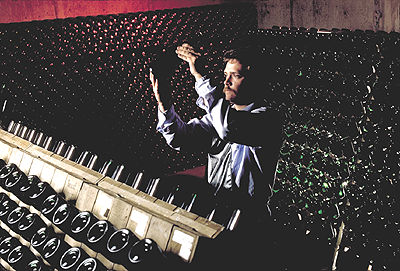Browse "Things"
-
Article
Flea
Fleas are very small, wingless, laterally flattened insects of the order Siphonaptera. They’re best known for being external parasites on mammals and occasionally birds. Adult fleas live in the fur or feathers of their hosts, feeding on their blood to survive and reproduce. While fleas do feed off humans, more common host animals include rodents, dogs and cats. The “human” flea, Pulex irritans, actually attacks a broad range of mammal species, and the same is true of most flea species that bite humans. About 2,000 species and subspecies are known worldwide, with at least 127 found in Canada, most of them in British Columbia and Alberta.
"https://d2ttikhf7xbzbs.cloudfront.net/media/media/0eca7c30-71f0-499e-ae2c-f9b6d8219faf.jpg" // resources/views/front/categories/view.blade.php
https://d2ttikhf7xbzbs.cloudfront.net/media/media/0eca7c30-71f0-499e-ae2c-f9b6d8219faf.jpg
-
Article
Fleur-de-lys
The fleur-de-lys, a symbol of the French presence in North America, has featured on the Quebec flag since 1948 and appears on the flags of a number of other French-speaking communities in Canada and the United States.
"https://d2ttikhf7xbzbs.cloudfront.net/media/media/98975740-c322-469b-9fe0-d603876f072d.png" // resources/views/front/categories/view.blade.php
https://d2ttikhf7xbzbs.cloudfront.net/media/media/98975740-c322-469b-9fe0-d603876f072d.png
-
Article
Floods in Canada
Floods are primarily caused by naturally occurring changes in the height of rivers, lakes and oceans. According to Public Safety Canada, floods are the most common natural hazard in the country and among the costliest. Historic floods have occurred across Canada, with many of the worst happening on major river systems that pass through populated areas. Scientists predict that flooding linked to the impacts of climate change will increase as the 21st century progresses, particularly in coastal areas of the country.
"https://d2ttikhf7xbzbs.cloudfront.net/media/media/86edab5a-1476-4145-911f-6e0a94bb25cc.jpg" // resources/views/front/categories/view.blade.php
https://d2ttikhf7xbzbs.cloudfront.net/media/media/86edab5a-1476-4145-911f-6e0a94bb25cc.jpg
-
Article
Floras and Botanical Journals
Before 1900 a published "flora" was, loosely defined, a comprehensive, itemized description of the plants of a specific geographical region. Usually more than a mere list, it should have been an analytical description, discussing habitats and distribution and citing previous authorities.
"https://d2ttikhf7xbzbs.cloudfront.net/media/media/51ac5d7f-0f57-4858-b967-2b6ee584bfc5.jpg" // resources/views/front/categories/view.blade.php
https://d2ttikhf7xbzbs.cloudfront.net/media/media/51ac5d7f-0f57-4858-b967-2b6ee584bfc5.jpg
-
Article
Flour Milling
In North America in precontact times, Indigenous people hand-ground corn and other substances (eg, acorns) into flour used in porridge, flat cakes, etc. By the middle of the 16th century, the first European settlers had arrived in New France, bringing with them their flour milling technology.
"https://d2ttikhf7xbzbs.cloudfront.net/media/media/7bd60d6b-69f6-4c5a-8511-05e7168b0127.jpg" // resources/views/front/categories/view.blade.php
https://d2ttikhf7xbzbs.cloudfront.net/media/media/7bd60d6b-69f6-4c5a-8511-05e7168b0127.jpg
-
Article
Fly
Adult flies have sucking or piercing mouth parts and lack the mandibles with which other insects bite food. Many so called "biting flies" (eg, horseflies, mosquitoes, no-see-ums, black flies, stable flies, tse-tse flies) feed on VERTEBRATE blood.
"https://d2ttikhf7xbzbs.cloudfront.net/media/media/1411b444-a35b-4113-8841-686fbe20b642.jpg" // resources/views/front/categories/view.blade.php
https://d2ttikhf7xbzbs.cloudfront.net/media/media/1411b444-a35b-4113-8841-686fbe20b642.jpg
-
Article
Fog
Fog, concentration of atmospheric particles (usually minute water droplets or ICE crystals) of sufficient density to reduce visibility.
"https://development.thecanadianencyclopedia.ca/images/tce_placeholder.jpg?v=e9dca980c9bdb3aa11e832e7ea94f5d9" // resources/views/front/categories/view.blade.php
https://development.thecanadianencyclopedia.ca/images/tce_placeholder.jpg?v=e9dca980c9bdb3aa11e832e7ea94f5d9
-
Editorial
Fog Bowl: The 1962 Grey Cup
The following article is an editorial written by The Canadian Encyclopedia staff. Editorials are not usually updated. The Grey Cup was donated by Albert Henry George Grey, yet another of those governors general who have left their monikers on our sporting life.
"https://development.thecanadianencyclopedia.ca/images/tce_placeholder.jpg?v=e9dca980c9bdb3aa11e832e7ea94f5d9" // resources/views/front/categories/view.blade.php
https://development.thecanadianencyclopedia.ca/images/tce_placeholder.jpg?v=e9dca980c9bdb3aa11e832e7ea94f5d9
-
Article
Folk Music
Few countries possess a folk music as rich and culturally varied as Canada's. Traditional folk music of European origin has been present in Canada since the arrival of the first French and British settlers in the 16th and 17th centuries (see Folk Music, Anglo-Canadian; Folk music, Franco-Canadian).
"https://development.thecanadianencyclopedia.ca/images/tce_placeholder.jpg?v=e9dca980c9bdb3aa11e832e7ea94f5d9" // resources/views/front/categories/view.blade.php
https://development.thecanadianencyclopedia.ca/images/tce_placeholder.jpg?v=e9dca980c9bdb3aa11e832e7ea94f5d9
-
Article
Folklore
Folklore was first introduced as a term in England in 1846 and today refers to information, wisdom and human expression that is passed on, usually anonymously, from generation to generation or transmitted and circulated as traditional cultural behaviour. Folkloric materials can be found anywhere and in any form, although past scholarship has favoured verbal folklore or oral literature: folk songs, folktales, epic, myth, legend, folk drama, riddles, proverbs, sayings and a variety of verses. Nonverbal folklore includes material culture such as folk architecture, folk art and crafts, dance, music, custom, ritual and belief, traditional folkways and amusements.
"https://d2ttikhf7xbzbs.cloudfront.net/media/media/49b9afe1-8c02-45cb-a6d3-75b557d095a4.jpg" // resources/views/front/categories/view.blade.php
https://d2ttikhf7xbzbs.cloudfront.net/media/media/49b9afe1-8c02-45cb-a6d3-75b557d095a4.jpg
-
Article
Food Additives
Consumers normally consider that the term "food additive" refers to almost all substances, primarily chemical in nature, added to foods during production, manufacture, packaging or storage.
"https://development.thecanadianencyclopedia.ca/images/tce_placeholder.jpg?v=e9dca980c9bdb3aa11e832e7ea94f5d9" // resources/views/front/categories/view.blade.php
https://development.thecanadianencyclopedia.ca/images/tce_placeholder.jpg?v=e9dca980c9bdb3aa11e832e7ea94f5d9
-
Article
Food and Beverage Industries
Food and beverage processing or manufacturing is one of Canada's major secondary industries and a vital component of the nation's overall AGRIBUSINESS system.
"https://d2ttikhf7xbzbs.cloudfront.net/media/media/39964bb9-1238-4a9b-bb81-ffdfe5205639.jpg" // resources/views/front/categories/view.blade.php
https://d2ttikhf7xbzbs.cloudfront.net/media/media/39964bb9-1238-4a9b-bb81-ffdfe5205639.jpg
-
Article
Food Banks
In Canada, the term "food bank" is often used to describe any cache of food designated for charitable purposes.
"https://development.thecanadianencyclopedia.ca/images/tce_placeholder.jpg?v=e9dca980c9bdb3aa11e832e7ea94f5d9" // resources/views/front/categories/view.blade.php
https://development.thecanadianencyclopedia.ca/images/tce_placeholder.jpg?v=e9dca980c9bdb3aa11e832e7ea94f5d9
-
Article
Food Insecurity in Canada
Household food insecurity— the inadequate or insecure access to food due to financial constraints — is a serious public health problem in Canada. In 2017–18, 1 in 8 households were food insecure. This amounted to over 4.4 million Canadians. Of that number, 1.2 million were children under 18 years. While food banks are a well-known public response to food insecurity, most food insecure households do not use food banks and there is no evidence that food charity is a durable solution. There is wide consensus that governments need to act on food insecurity through income-based interventions.
"https://d2ttikhf7xbzbs.cloudfront.net/media/new_article_images/FoodInsecurityCanada/food-insecurity-map.jpg" // resources/views/front/categories/view.blade.php
https://d2ttikhf7xbzbs.cloudfront.net/media/new_article_images/FoodInsecurityCanada/food-insecurity-map.jpg
-
Article
Food Legislation
Legislation designed to prevent the sale of unsafe or unwholesome food represents one of the oldest forms of governmental or societal intervention in the AGRICULTURE AND FOOD system.
"https://development.thecanadianencyclopedia.ca/images/tce_placeholder.jpg?v=e9dca980c9bdb3aa11e832e7ea94f5d9" // resources/views/front/categories/view.blade.php
https://development.thecanadianencyclopedia.ca/images/tce_placeholder.jpg?v=e9dca980c9bdb3aa11e832e7ea94f5d9
